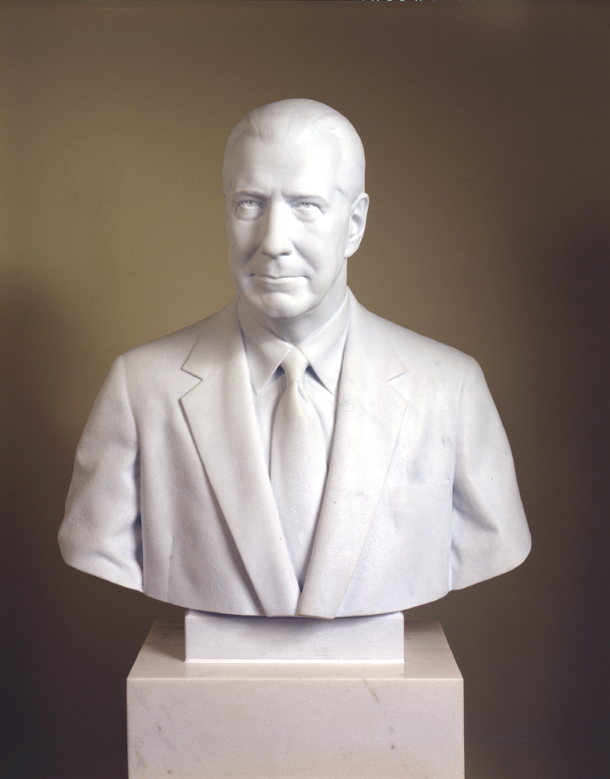
| Title | Spiro T. Agnew |
| Artist/Maker | William Frederick Behrends ( 1946 - Present ) |
| Date | 1995 (carved), 1993 (modeled) |
| Medium | Marble |
| Dimensions | h. 27.5 x w. 23.13 x d. 11.75 in. (h. 69.9 x w. 56.2 x d. 57.8 cm) |
| Credit Line | U.S. Senate Collection |
| Accession Number | 22.00043.000 |
In 1992 the Senate Committee on Rules and Administration agreed to commission a marble bust of Spiro Agnew for the Senate’s Vice Presidential Bust Collection. Whereas ordinarily the bust would have been commissioned shortly after Agnew left office, the circumstances surrounding his departure resulted in a lengthy delay. In a letter to then-Rules Committee Chairman Ted Stevens, Agnew noted that although his staff and the staff of the architect of the Capitol had begun discussing the subject prior to his resignation, nothing further had transpired. The eventual decision to commission the bust was based on historical precedent: the 1886 Senate resolution establishing the collection calls for a marble bust of each vice president to be installed in the Capitol without reservation.
Architect of the Capitol George White recommended North Carolina sculptor William Behrends for the commission, and Agnew approved this selection. Behrends relied on period photographs of the former vice president to portray him as he appeared during his term in office. The sculptor also visited Agnew for four sittings during the summer of 1993 in Ocean City, Maryland, where the former vice president spent part of each year. Behrends noted, “He was a good model, easygoing, relaxed. And he’s a great subject for marble. He’s got that nose, that strong face.” [1] The artist traveled to Italy to select the marble, and carved the piece at his studio in Tryon, North Carolina.
Behrends studied architecture at North Carolina State University and completed his academic studies in fine arts and sculpture at the University of North Carolina at Chapel Hill. He furthered his training in Pietrasanta, south of Carrara, Italy, where carvers of fine sculpture still follow traditional methods. He currently maintains a studio in Tyron, North Carolina. Other works by the sculptor include a monumental bronze bust of Andrew Johnson at the Tennessee State Capitol, a statue of Henry Ford II at Ford World Headquarters in Detroit, and a bronze statue of Buck O’Neil at the National Baseball Hall of Fame in Cooperstown, New York. Behrends has completed three vice presidential busts for the Senate: Vice President Spiro T. Agnew in 1995, Vice President Richard B. Cheney in 2015, and Vice President Albert A. Gore in 2017.
The bust of Agnew was unveiled at ceremonies held at the Capitol on May 24, 1995—almost 22 years after Agnew left public office. The former vice president was moved by the occasion, and his voice broke more than once during his address. Agnew made no mention of his resignation but instead focused on the office he once held, commenting, “I’m not blind and deaf to the critics that feel this is a ceremony that should not take place. This ceremony has less to do with Spiro Agnew than the office I held, which was conferred upon me when the American people elected and re-elected me vice president of the United States.” [2]
1. Maureen Dowd, “Sic Transit Agnew,” New York Times Sunday Magazine, 31 July 1994.
2. Juliet Eilperin, “Agnew Immortalized,” Roll Call, 25 May 1995.
Spiro Theodore Agnew, the 39th vice president of the United States, was born in Baltimore, Maryland. Agnew served in the U.S. Army during World War II and was awarded a Bronze Star. In the 1950s, after establishing a law practice in the Baltimore suburbs, Agnew became active in local politics. From 1962 to 1966 he served as Baltimore County executive–the first Republican to hold that office in the 20th century–and was elected governor of Maryland in 1966. Two years later Richard Nixon chose the relatively unknown Agnew to be his vice presidential running mate. Despite allegations of financial misconduct leveled at the governor, the Nixon-Agnew ticket won by a narrow margin.
As vice president, Agnew was known for his strong criticism of antiwar demonstrators and his comments on bias in the news media. Shortly after his reelection in 1972, Agnew faced charges of past bribery and tax fraud dating from his governorship. He resigned from office on October 10, 1973, pleading no contest to tax evasion. He was fined $10,000 and given a suspended prison sentence; the government agreed not to prosecute him on charges of bribery and extortion. After he was disbarred in Maryland, Agnew moved to Rancho Mirage, California, where he conducted business in international trade and wrote his memoirs and a novel. Agnew died in 1996.